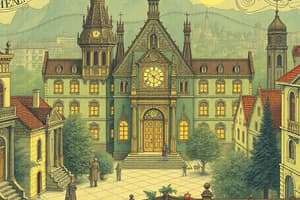Podcast
Questions and Answers
What is blockbusting?
What is blockbusting?
- A process encouraging urban development
- A process where agents convince white homeowners to sell low due to fear of black families (correct)
- A technique for increasing property values
- A method of urban renewal
What does census data refer to?
What does census data refer to?
A periodic and official count of a country's population
What is a central business district?
What is a central business district?
The downtown or nucleus of a city where retail stores, offices, and cultural activities are concentrated
What is commodification?
What is commodification?
DINKs refers to households that have two incomes and children.
DINKs refers to households that have two incomes and children.
What is an example of a disamenity zone?
What is an example of a disamenity zone?
What is an economic sector?
What is an economic sector?
What are edge cities?
What are edge cities?
What is gentrification?
What is gentrification?
What are greenbelts?
What are greenbelts?
What does infrastructure refer to?
What does infrastructure refer to?
What is land use?
What is land use?
What are megacities?
What are megacities?
What is a megalopolis?
What is a megalopolis?
What constitutes a metropolitan area?
What constitutes a metropolitan area?
What is mixed-use design?
What is mixed-use design?
What is the multiplier effect?
What is the multiplier effect?
What is new urbanism?
What is new urbanism?
What does NIMBY stand for?
What does NIMBY stand for?
What is a primate city?
What is a primate city?
What are public services?
What are public services?
What does 'range of a service' refer to?
What does 'range of a service' refer to?
What is redlining?
What is redlining?
What does sanitation refer to?
What does sanitation refer to?
Flashcards are hidden until you start studying
Study Notes
Key Concepts in Urban Geography
-
Blockbusting: A tactic where real estate agents persuade white homeowners to sell their properties at low prices due to fears of black families moving into the neighborhood, prevalent in the US during the 1960s and 1970s.
-
Census Data: An official count of a country's population, conducted at regular intervals, exemplified by the United States census in 2010.
-
Central Business District (CBD): The core area of a city characterized by high concentrations of retail, office buildings, and cultural activities, with significant building density and converging transportation systems, seen in cities like Washington D.C. and Baltimore.
-
Commodification: The process of assigning monetary value to goods or services, including raw materials such as agricultural products.
-
DINKs: Refers to households with dual incomes and no children, typically consisting of working couples without offspring.
-
Disamenity Zone: The poorest urban areas, often lacking basic city services and controlled by gangs or drug lords, exemplified by locations like Mexico's maquiladoras.
-
Economic Sector: Divisions within an economy, such as primary (agriculture), secondary (manufacturing), and tertiary (services) sectors.
-
Edge Cities: Predominantly commercial areas that develop on the outskirts of urban regions, exemplified by Arlington in the Dallas-Fort Worth area.
-
Gentrification: The transformation of urban neighborhoods from low-income renting areas to middle-class owner-occupied areas, as seen in Denver's lower downtown district.
-
Greenbelts: Designated open spaces preserved in their natural state, such as Central Park in New York City.
-
Infrastructure: Essential facilities and services that support the functionality of a community, including roadways and public transport networks.
-
Land Use: The categorization of how land is utilized, which can include agriculture, residential, commercial, etc.
-
Megacities: Urban areas that experience significant population growth, leading to large and densely populated cities like Shanghai.
-
Megalopolis: A vast urban area formed by the merging of multiple metropolitan regions, such as the urbanized northeastern corridor of the United States.
-
Metropolitan Area: A region that encompasses a core city with a population of 50,000 or more, including surrounding suburbs and exurbs.
-
Mixed-use Design: Urban planning approach combining residential and commercial development in a single area, evidenced by Marina City in Chicago.
-
Multiplier Effect: An economic principle where an increase in spending results in greater overall economic growth than the initial expenditure, often observed in tourist areas.
-
New Urbanism: A design movement advocating for walkable neighborhoods and diverse housing options, originated by international urban planners and architects, seen in developments like Beacon Cove in Port Melbourne.
-
NIMBY (Not In My Back Yard): A phenomenon where individuals oppose placing unwanted facilities or developments in their vicinity while having no objections to similar projects elsewhere.
-
Primate City: The largest urban center in a given country or region, significantly larger than any other city within the same area; examples include Paris, France.
-
Public Service: Government-provided services aimed at securing the welfare and safety of citizens and businesses, such as law enforcement.
-
Range (of a Service): The farthest distance consumers are willing to travel to access a service, often cited as around 15 miles.
-
Redlining: An unethical discriminatory practice that restricts access to services based on race or ethnicity, often denying loans or services to residents in specific areas.
-
Sanitation: Health conditions associated with the availability of clean drinking water and effective sewage disposal, crucial for public health, such as indoor plumbing systems.
Studying That Suits You
Use AI to generate personalized quizzes and flashcards to suit your learning preferences.




